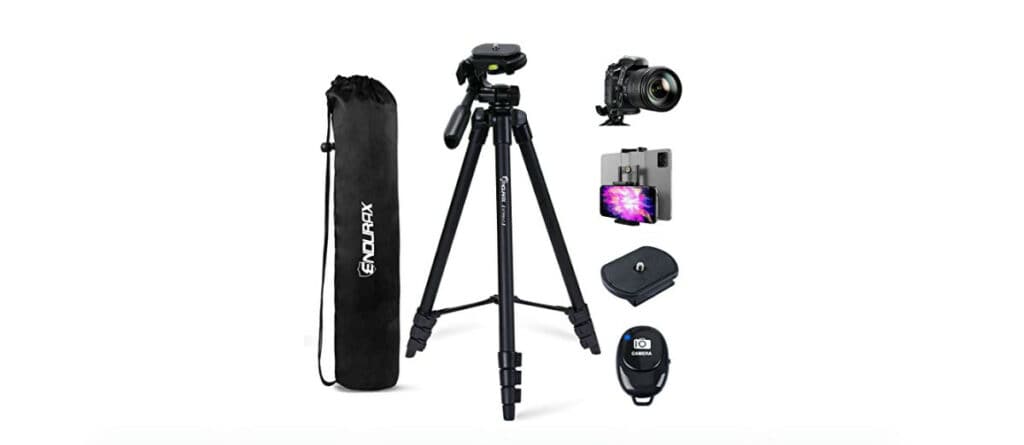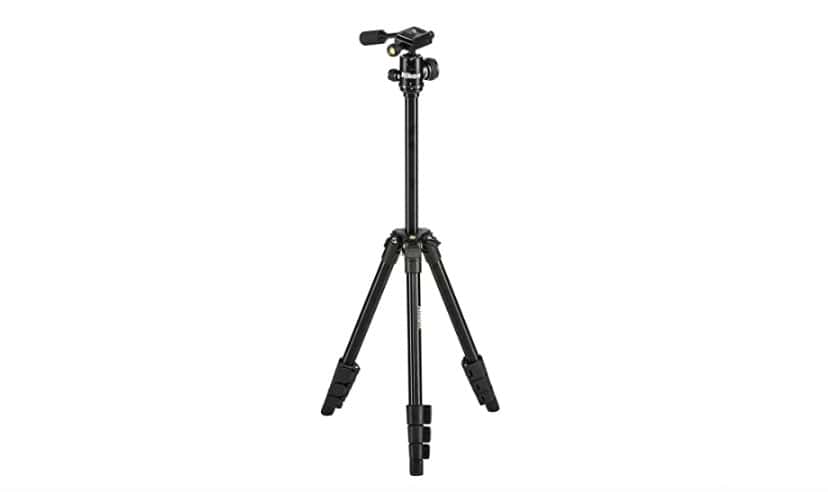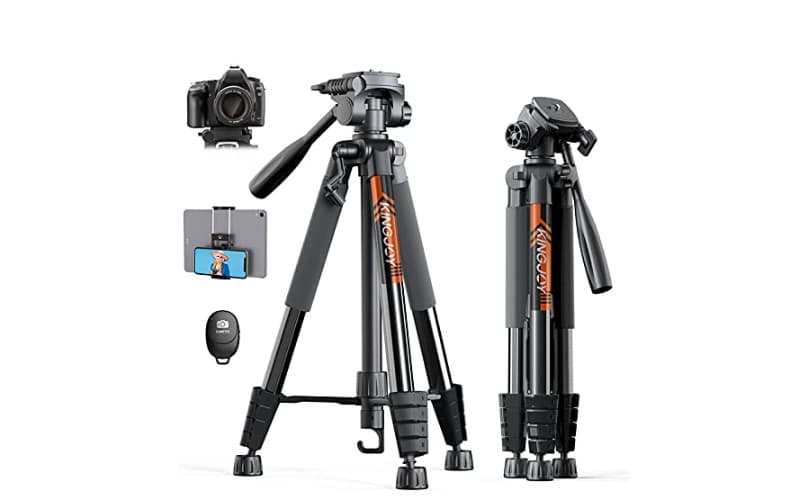
Endurax 60” Camera Tripod Camera Stand for Canon Rebel Eos Nikon DSLR

Nikon Compact Outdoor Tripod

KINGJOY 75″ Camera Tripod for Canon Nikon Lightweight Aluminum DSLR Camera Stand
Tripods make a massive difference to the quality of your photography. While it goes without saying that expensive tripods are better than cheap ones, there’s a lot that even a low-end tripod can do which will improve your images.
Many models are designed with particular camera/lens setups in mind, but they’re also very capable of serving a variety of similarly sized pieces of kit.
Tripods are a great accessory to invest in, and luckily, Nikon’s D5300 is a lightweight camera that even comes with a kit lens that has a vibration reduction (VR) feature.
This allows you to take clearer photos and videos because it quickly compensates for your movements. Tripods also allow for more flexibility when taking photos, as well as keeping the camera steady in windy locations.
Here are the best tripods you can consider using.
1. Endurax 60” Camera Tripod Camera Stand for Canon Rebel Eos Nikon DSLR
The Endurax 60-Inch Folding Camera Tripod is an excellent tripod for the price. The legs are lockable, which makes it easy to set up and take down without worrying about your camera falling over. It comes with a carrying bag so you can easily transport it when traveling.
This tripod is lightweight and portable, so you can take it anywhere you want to go. It also has a built-in bubble level, which helps ensure your pictures are leveled out before you take them.
Features
- Quick Release Plate-Assists in the camera installation and removal in seconds.
- It allows for quick transitions between shots and moving from spot to spot.
- The built-in bubble level aids in precise horizontal alignment.
- Endurx Camera Tripod Has a 360-Degree Swivel Function, Allowing for Tilt and Swivel Motion, Portrait Or Landscape Options.
- 1x Tripod, 1x Phone/ Tablet Holder, 1x Remote Shutter, and 1x Carry Bag Endurax is an excellent choice if you want a camera stand that is both affordable and high-performing.
Performance And Functionality
The Endurax 60″ Camera Tripod is a versatile tripod that can be used as a general-purpose tripod or macro shooting tripod. This is a lightweight and strong tripod with a maximum load capacity of 50 pounds (23 kg). The top plate has a quick-release plate for fast mounting and dismounting your camera.
It features three leg sections, each with independent leg angle adjustment for added stability and fine-tuning the height of the camera head.
The center column can be removed to extend the height from 16″ to 60″, making it useful for macrophotography or when you need to get low down on the ground to take photos of flowers or insects, etc.
This tripod comes complete with an attractive carry bag which makes it easy to transport around with you wherever you go!
User Interface And Control System
The Endurax 60” Camera Tripod is a professional tripod with an aluminum alloy tube and a ball head. It can extend to a maximum height of 60 inches, providing a stable base for your camera.
The tripod is durable and sturdy, making it ideal for outdoor use. The three legs are made of aluminum alloy and can be folded into a compact form when not used. The 3-section extension makes it easy to adjust the height of your camera.
It comes with a ball head that allows you to rotate 360 degrees while holding your camera firmly. This means you can take pictures from any angle without worrying about them falling over or slipping out of position.
The feet at the bottom of the tripod have rubber pads on them to prevent them from slipping on different surfaces, such as grass or sand.
Build Quality And Design
The Endurax 60” Camera Tripod is a great choice for those who want to get the most out of their DSLR camera. It’s lightweight, sturdy, and versatile. This tripod is designed for use with SLR cameras and camcorders. The legs are made of steel, making them strong and durable.
The tripod comes with a three-way head that can be adjusted to any angle you want. You can also pan and tilt the camera up or down.
The ball head has a quick-release plate that allows you to easily attach your camera to the tripod in seconds without using any tools whatsoever. This tripod is compatible with all types of DSLRs, including Canon Rebel Eos, Nikon D3100, Nikon D5300, Nikon D7000, and more.
2. Nikon Compact Outdoor Tripod
The Nikon Compact Outdoor Tripod is a tripod that has been designed to allow you to take great shots and videos in any environment. It is a lightweight, compact, and easy-to-use tripod that will allow you to capture the best possible images.
The Nikon Compact Outdoor Tripod comes with a ball head mount and an adjustable center column, which can be set at different levels. This allows you to capture images from different angles without having to move around too much or risk getting tired during the process.
Features
- The Nikon Compact Outdoor Tripod is a lightweight, sturdy tripod designed for outdoor use.
- This tripod features quick-flip leg locks, rubber feet, and an adjustable center column.
- It can be used with a wide range of cameras, from point-and-shoot models to DSLRs.
- The legs have flexible joints that allow them to fold up, making it easier to carry the tripod around in your camera bag. When you’re ready to use the tripod, fold-out one leg at a time until it locks into place.
- This tripod has a 3-way pan head that lets you adjust your camera’s position in three different ways: by rotating it horizontally, moving it vertically, and tilting it side to side.
- The head also has a bubble level, so you can ensure your camera is level with the horizon before taking photos or videos.
Performance And Functionality
The Nikon CP-N10 is a small, lightweight, and affordable tripod that is perfect for the Nikon D5300 DSLR camera. It has a ball head with a quick-release plate that allows you to mount and dismount your camera easily.
The legs can be extended to provide stability at different angles. The quick-release plate lets you quickly remove your camera without loosening any screws. It can support up to 4.5 pounds of weight, making it ideal for most DSLRs.
This tripod comes with a carrying bag so that it will be easy to transport and store when not in use. This product is backed by Nikon’s limited lifetime warranty against manufacturing defects which covers all parts and labor costs should anything happen to go wrong during normal use of this product.
User Interface And Control System
The Nikon Compact is a lightweight, portable tripod with a fluid head. It features three quick-release plates and can be used with all lenses. The tripod also comes with a carrying bag, so it’s easy to transport and store.
The legs of this tripod are made from aluminum and can extend up to 5 feet high. The tripod has rubber feet on the bottom to prevent slipping and protect surfaces from scratches. The legs also have a locking mechanism that prevents them from collapsing.
This tripod is great for photographers who want something lightweight but sturdy enough to hold their camera equipment.
The Nikon Compact has a quick-release plate that allows users to attach their cameras easily without having to unscrew anything at all.
This makes it easier for photographers who like using different cameras or switching between using a camera and taking pictures through the viewfinder on the back of their camera body.
Build Quality And Design
The Nikon Compact Tripod is a very simple, easy-to-use, and lightweight tripod designed by Nikon. The tripod is made from aluminum, and it has a rubberized foot. This ensures that the tripod is stable and secure when in use. It also makes it easy to carry around with you.
The legs of the tripod can be folded up or down easily, making it easy to carry around in your bag or backpack. There are also three different leg angles that can be adjusted easily, allowing you to get the perfect angle for your shot.
The legs also have rubberized feet, which allow them to stay firmly planted even on slippery surfaces like rocks or wet rocks. The rubberized feet are also great for protecting your camera from scratches and other damage as well as protecting the surface it is sitting on from damage too!
This compact tripod works great for all types of photography, from landscapes to portraits and more!
3. KINGJOY 75″ Camera Tripod for Canon Nikon Lightweight Aluminum DSLR Camera Stand
The KINGJOY 75″ Camera Tripod for Canon Nikon Lightweight Aluminum DSLR Camera Stand is an excellent product. It’s easy to set up and has a good range of adjustments. The lightweight aluminum makes this tripod very easy to carry around, and it’s also very sturdy.
Features
- All-steel construction with a durable black finish, the tripod is lightweight and compact, easy to carry around.
- It has a compact design that makes it ideal for travel, but it’s strong enough to support your DSLR camera with a telephoto lens attached.
- The quick-release plate makes it easy to switch between different cameras and lenses.
- The three-leg sections are independently adjustable and can be set at different angles for greater stability on uneven surfaces or windy conditions.
Performance And Functionality
The Kingjoy 75″ Camera Tripod is a lightweight aluminum tripod that will be a great fit for your Nikon D5300. It’s easy to set up and take down, so you can get the shot you want in no time. The height of this tripod is adjustable from 13″ to 37″, so it can be used for just about any situation.
This tripod also comes with a smartphone adapter, which allows you to use your phone as a remote trigger for your camera. This means no more blurry photos from pushing the shutter button with your finger!
The Kingjoy 75″ Camera Tripod is made of durable aluminum and features rubber feet on its legs to keep it from slipping around on smooth surfaces.
User Interface And Control System
The Kingjoy 75″ Camera Tripod for Canon Nikon Lightweight Aluminum DSLR Camera Stand is a great option for photographers who want to travel light and still capture great images.
This compact tripod is easily folded and weighs only 0.7 pounds, so it won’t weigh down your bag or get in your way as you’re hiking around.
The Kingjoy’s legs are made from aluminum alloy, which makes them strong and lightweight, while the rubber feet keep the tripod stable on any surface.
The camera mounting plate is made from plastic, so it won’t scratch your camera’s finish while attaching or removing it from the tripod.
The Kingjoy features a ball head that allows 360-degree rotation and 90-degree tilt movement, allowing you to find just the right angle for every shot.
The head also has a quick-release button that allows you to attach or remove your camera with one hand while leaving your other hand free to hold onto something else, like a railing or tree branch, if needed.
Build Quality And Design
This tripod is made from aluminum alloy and is lightweight enough to be used in the field or out in the open. It even comes with a hook on top, so you can hang your camera bag while working.
The legs on this tripod can be adjusted between 19″ and 55″. There are rubber feet on the bottom of each leg, so your gear won’t slip around when using this tripod in the field or windy conditions.
One thing that stands out about this tripod is how easy it is to set up and use. All the adjustments are made using levers instead of screws or knobs, so there’s no need for tools to adjust how tall or short you want your gear to be standing up!
What Features Should You Consider While Buying a Tripod for Nikon D5300?
If you are a photographer, you must be aware of the importance of tripods. Tripods are one of the essential accessories that every photographer must have. They come in handy while shooting landscapes, portraits, wildlife, and much more.
Here are some of the features you can consider while buying a tripod for the Nikon D5300.
1. Tripod Weight
The tripod’s weight should be considered while buying it because heavier tripods have more stability than light ones. If you want to take long exposure shots or shoot in low-light situations, you should go for a heavy and stable tripod; otherwise, you can also buy a light tripod.
2. Height Adjustment:
The height adjustment feature is very important when choosing a tripod for your DSLR camera because it lets users adjust the height as per their needs and requirements. Some people like using lower-angle shots, while others prefer higher-angle shots.
Therefore, the height adjustment feature is very useful here!
3. Weight Capacity
The weight capacity of a tripod refers to how much weight it can hold without toppling over or collapsing under pressure (e.g., when there’s wind).
If you’re planning on using your camera with heavy lenses and other accessories attached, ensure that this number is large enough; otherwise, your equipment might fall off!
4. Material
Tripods are made of materials like aluminum, carbon fiber, plastic, etc. Aluminum is one of the most common materials used in tripods because it is lightweight, strong, and sturdy enough to support DSLR cameras.
Carbon fiber is another material used in making tripods, as it reduces weight while retaining strength and durability. Plastic is not very durable, but it comes at an affordable price tag, making it an attractive option for budget shoppers.
A good quality tripod will have a combination of all these materials so that maximum strength can be gained without compromising on portability or cost-effectiveness too much!
5. Durability
Another important feature to look out for a while buying a tripod for your Nikon D5300 is durability. Most photographers prefer buying aluminum tripods because they are sturdy and can hold up well against rough handling over time.
You should also check if your chosen tripod has ball heads or pan heads so that you can easily control the movement and angle of your camera on-location shoots.
How Can You Connect Your Nikon D5300 To a Tripod?
When you’re starting your D5300, it’s important to know how to connect your camera to a tripod. The obvious reason is so that you can get the sharpest possible images.
The less obvious reason is to stay steady when taking long exposures or using an extremely wide-angle lens. You’ll also find that using a tripod is great for keeping your camera steady in windy conditions or when shooting video.
The Nikon D5300 has a tripod socket on the bottom of the camera body, which means you can mount it directly onto a tripod without any additional equipment.
However, since the socket isn’t centered on the bottom of the camera, it will be difficult (if not impossible) to balance the camera on its own if it doesn’t have any weight in front of it (such as a battery grip).
In addition, since there’s no quick-release plate available for this model, attaching and removing your camera from its tripod will take some time and effort.
How Do You Use A Camera Tripod?
You can use a camera tripod in various ways, depending on your available time and the type of photo or video you want to create. Some of these include.
Taking Time-Lapse Photos is one of the most common uses for a camera tripod. Time-lapses are created by taking photos at regular intervals throughout the day or night; they are combined into a video file or series of stills.
The result is a slowed-down view of what normally happens over several hours or days condensed into seconds or minutes of footage.
This can be very effective when used on its own or combined with other filming techniques, such as slow-motion video or stop-motion photography (also known as claymation).
Benefits Of Using Tripod With Camera
A tripod is a device that supports a camera or other photographic equipment, such as a telescope or binoculars. Tripods are made from many different materials with different designs that offer specific benefits.
A tripod can be used in a number of ways. The most common use is stabilizing the camera when taking an image. For example, if the shutter speed is slow and windy, you may get blurry images due to the camera shake caused by your hands.
Tripod-mounted cameras also allow you to set much higher ISO values than hand-held cameras, making capturing images in low-light situations easier.
Some tripods have legs that extend outwards to make them easier to place on uneven surfaces like grass or sand dunes; others have legs that fold up into themselves, so they’re easier to carry around on hikes and other outdoor adventures.
A tripod helps eliminate camera shake caused by the photographer’s movement, especially when shooting in low light or with slow shutter speeds (e.g. to create motion blur).
When you use a tripod, you can also use longer shutter speeds than you would be able to without one. A good example is when photographing landscapes at night; without a tripod, you might use an exposure time of 1/30th second, but with one, you could use up to 4 minutes!
Conclusion
A camera tripod is a very useful tool for photographers. It allows you to take pictures from high and low positions. It also helps you stabilize your camera when shooting in low light conditions or using long shutter speeds.
